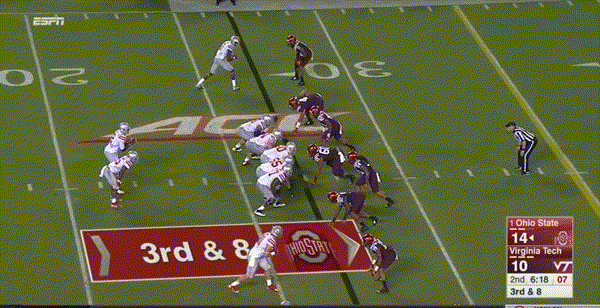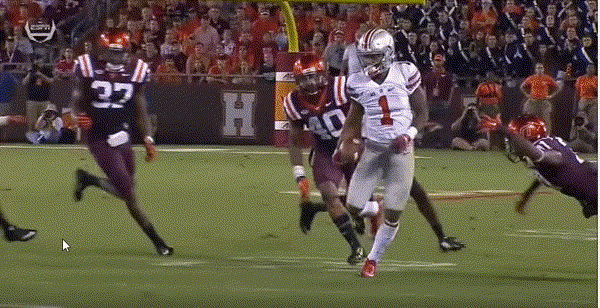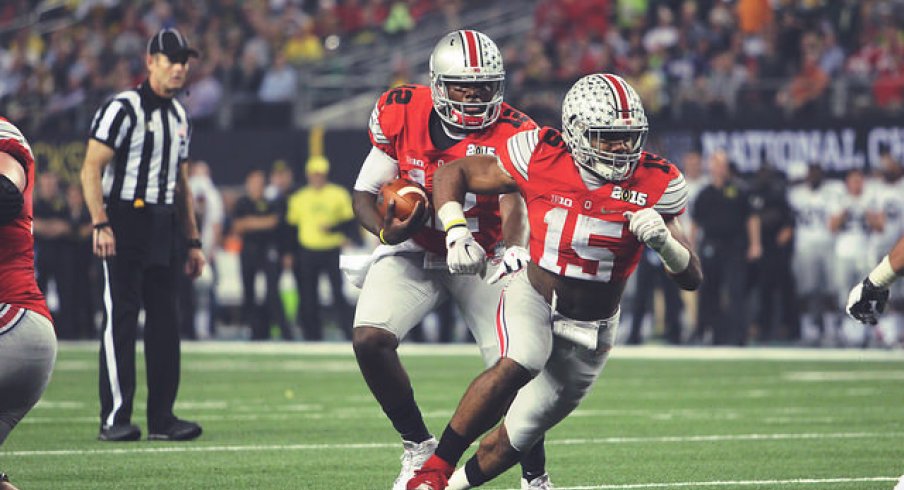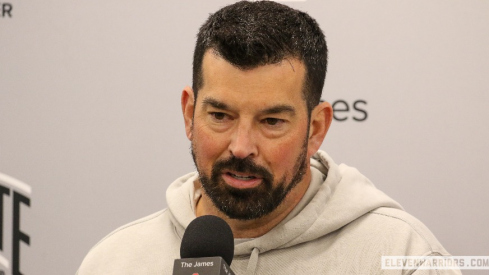If you want to play running back in Ohio State head coach Urban Meyer’s offense, you better be able to block.
Meyer’s marriage of zone and gap concepts into a coherent system that can be run through a tailback or quarterback is the hallmark of his offensive philosophy. He has repeatedly emphasized his desire to establish an aggressive, physical run-game that forces the defense to choose between a one-high or two-high alignment (the number of deep safeties), creating a numbers advantage on the ground or through the air.

The roots (and evolution) of the three-time national champion’s run game can be traced back to his first head coaching job at Bowling Green. A look at Meyer’s 2002 playbook reveals several base concepts Buckeye fans will recognize, including Tight Zone, Outside Zone, and QB Counter:


14 seasons later, two core tenants can still be seen in Meyer’s philosophy of bringing extra blockers to the point of attack:
- The use of a ‘read man’ to option defenders out of the play.
- The quarterback/wide receiver run game, in which the tailback becomes a vital part of the blocking scheme.
While countless national media resources (including Eleven Warriors) have broken down the use of the read men in the base Ohio State run game, few have focused on the running back’s vital role in bringing an extra blocker to the line of scrimmage. Because Ohio State offense heavily relies on the quarterback and wide receiver run game to move the ball, the running back’s ability to block can be the difference between consistent explosive plays or negative gains.
The Buckeyes have been blessed with a seemingly never-ending group of talented running backs during Meyer’s tenure, but no skill player has embraced and excelled at the role of blocking like future NFL first-round draft pick Ezekiel Elliott.
Not surprisingly, Elliott introduced Ohio State fans to his physical style of play without the ball in his hands, blowing up a Purdue kickoff return during a freshmen year in which he primarily played (and excelled at) special teams.

During the St. Louis native’s breakout 2014 sophomore season (1,878 rush yards and 18 touchdowns) coaches and teammates were quick to praise his physicality, tenacity, and effort on plays in which he didn’t touch the ball.
Fellow future NFL draft pick Taylor Decker said of Elliott, "Watch him play without the ball; some of his best plays you could say are plays he makes without the ball. He kind of has an offensive lineman's mindset but he plays running back.”
On Elliott’s performance in Ohio State’s 2014 31-24 overtime victory over Penn State, Meyer said, “You know, this game last year, it was one of the best games I’ve seen a tailback play without the ball.”
While all teams require their running backs to block (think pass protection), Ohio State’s offense is unique in the both the volume and types of blocks the back is expected to make in the ground game. Due to the wealth of talent at the H-Back position, Tom Herman, Tim Beck, and Ed Warinner have leaned on the wide receiver Jet Sweep to get a their speedy skill position players in space:

Over the previous two seasons the Buckeye offense eliminated the mesh point (point where the quarterback and wide receiver meet to hand the ball off) on most of their jet sweeps, instead using a touch pass in which the ball is thrown up and slightly forward. It’s important to note that although the play technically counts as a pass attempt on the stat sheet, it is blocked like a run.
The jet sweep jump is blocked upfront like outside zone, with offensive linemen taking lateral steps towards the play (different coaches teach different steps here, but the principle is to reach the outside of the defender). The offense can use different blocking combinations on the frontside of the play based on the defense’s alignment, like the Pin-and-Pull seen here. The running back’s role is to lead the ball carrier around the corner, looking to pick up the first threat to his inside shoulder or the alley defender.
The right guard does a good job chipping the wide-5 technique, allowing the ball carrier to press upfield into a clean alley. Notice how quickly Elliott turns the corner, recognizes the WILL (No. 11) as a threat to his inside shoulder, and shows no hesitating chopping him down in space. Even with pads on, throwing the body into more than 200 pounds of bone and muscle moving at you will not feel good, but Elliott makes the business decision leading to an explosive gain.
Another play that shows up on tape over and over is the quarterback sweep, again blocked like outside zone with the running back leading the tailback around the corner.

The blocking assignments against this defensive front put the wide receivers on the defensive backs, the tight end on the standup linebacker, and the running back on a linebacker. Notice that Elliott doesn’t leave his feet on this block, instead dropping his hips to create a wide athletic base and using choppy steps as he delivers his block. By attempting to avoid the block in space, the linebacker allows himself to be sealed from the ball, creating a beautiful running for the quarterback.

Again, Elliott’s role is to lead around the corner, although he will block the alley defender as the tight end has picked up the playside linebacker. Elliott again leaves his feet to chop the defender’s legs, allowing the quarterback to cut upfield inside his block for a chunk gain.

The running back’s role in the ground game is not limited to leading a ball carrier around the corner and making open field blocks. The Buckeye’s gap-scheme plays often require the back to take the role of a power blocker, leading the quarterback through the hole to block a linebacker heads up. This is where men separate themselves from the boys. The block is straight downhill with limited space to work in; there is no hiding in the hole.
The Quarterback Counter is arguably Ohio State’s signature play over the previous two seasons. While the traditional Counter Trey pulls the backside (away from the play direction) guard and tackle, the Buckeye offense will run the play with just the backside guard pulling to kick out the EMLOS (End Man on Line Of Scrimmage) and the tailback leading through the hole.
The OSU ground unit put on a display of scheme versatility and execution in front of a national audience during its 49-37 victory over Michigan State in 2014. J.T. Barrett averaged 6.1 yard per rush and scored two touchdowns off several quarterback-centric run concepts, including the aforementioned QB Counter.

Elliott shows no hesitation leading through the hole to fit on the WILL linebacker (No. 43). Watch as he lowers his pad level at the point of contact (low man wins) to get underneath the defender, forcing he defender backwards and out of the play. Barrett does a great job reading the block (it is the ball carrier’s responsibility to read the block in the hole and make the appropriate cut) on his way to 56-yard gain.
In the Buckeye’s open-seasoning 42-24 victory over Virginia Tech, the QB Counter was again executed to create an explosive play on third-and-long.

The offensive line does a great job executing their blocks, leaving Elliott with no defender to meet in the hole. Instead he moves downfield, known as “looking for work”, and gets just enough of a linebacker to prevent the quarterback Cardale Jones from being tackled from behind, possibly ending the drive. This is another great example of Elliott’s effort and willingness to get his hands dirty. Many players become passive in this spot and look for token contact, but not Elliott.
Two downfield blocks the epitomize Elliott’s physicality and want-to occurred on passing plays in which he didn’t receive the ball.

Watch the effort to get downfield and attempt to block after carrying out the play action fake. For most tailbacks, the play is over after the fake is executed and the ball is out. Instead, Elliott hustles 15 yards upfield and attempts to spring his wide receiver for a long gain.
Braxton Miller’s spin move against Virginia Tech was likely college football’s video game moment of the year, but Elliott’s block was just as impressive. Watch him enter from the left-side of the screen and blow up a pursing defender behind the play.

Finally, no article about blocking would be complete without one last look at Elliott destroying Jabril Peppers in Ohio States season finale 42-13 victory over Michigan.

Cutups of Ezekiel Elliott’s blocking will be a film room mainstay for current and future Buckeyes to analyze for years to come. The OSU legend is a perfect example of the coaching point that technique will only take a player so far in the game of football. Although it has become cliché to say so, desire and willingness are what elevates a player’s performance from good to great. It’s fair to say that Elliott has set the standard in the blocking game for future Buckeye running backs.


